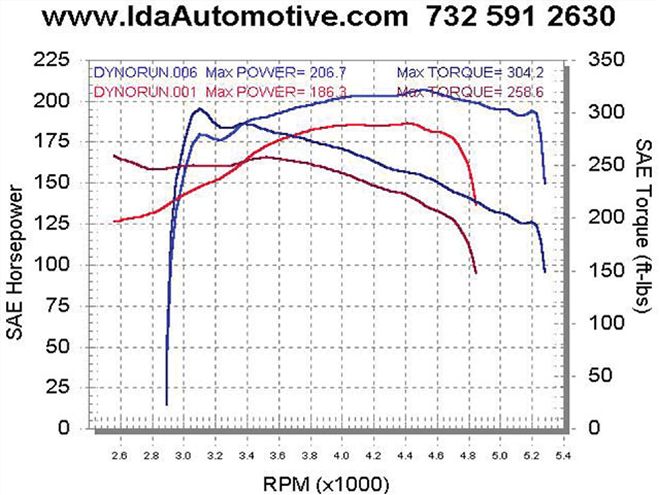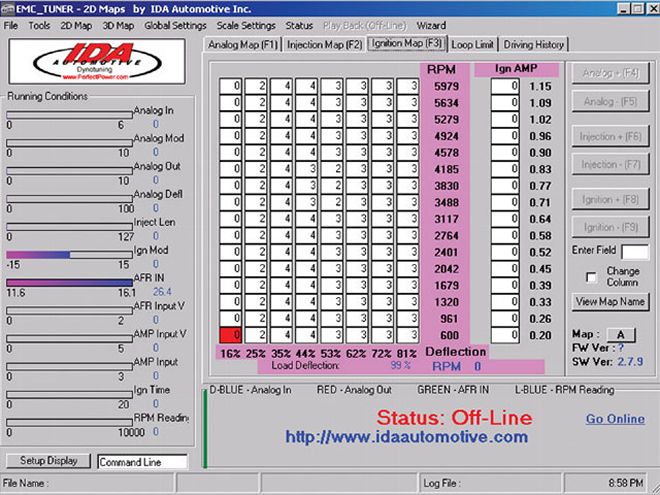
 Our test-bed engine-a 5.9 Magnum with slightly over 80,000 miles on it.
Our test-bed engine-a 5.9 Magnum with slightly over 80,000 miles on it.
The Achilles heel of Chrysler EFI performance has always been the calibration. Anyone who has delved into this sport beyond a cold air kit and exhaust system has stubbed his toe on the calibration issue. It started back when the first EFI-equipped engines were modified, and is even a bigger complication today because of OBD-II. Different approaches have been tried that range from hacking proprietary OE computer code to the integration of a stand-alone aftermarket ECU. All of these technologies have raised the bar and allowed power, along with drivability, to ratchet up a notch, but it is still not the answer. The complete system integration of other vehicle functions into the engine management system does not allow the removal of the factory ECU and, thus, has created an obstacle to having both horsepower and drivability, along with emissions compliance.
Finally, after nearly twenty years of failed attempts by the industry to cure the Mopar calibration blues, an ingenious product has been brought to market by Ida Automotive-the EMC Tuner.
The EMC Tuner is an ancillary computer wired in between the engine's sensors and the Mopar engine management system. An over-simplification of its function would be that it intercepts the sensor outputs and changes them to impact the fuel and timing commands to suit the needs of the particular engine, in line with the values inputted by the tuner. It must be understood that the EMC Tuner modifies the signals only and still needs the factory ECU to perform the work of pulsing the injectors and controlling the ignition timing.
The Better Mousetrap
The problem with the Mopar ECU has not been its quality or capabilities, but the lack of access to make the required changes to get the most power from a stock or modified engine. Whenever the power output is increased, the fuel and spark curve need to be reworked. Altered camshaft profiles or increased airflow through cylinder head modifications change not only the horsepower and torque, but at what rpm they occur. Forced induction and nitrous bring along their own set of issues and need accurate tuning to pay dividends while preserving the integrity of the engine. every engine has a slightly different tuning characteristic than its identical twin. This often leaves some horsepower and drivability on the table, even on a completely stock vehicle as our subject '01 Durango. The Durango utilizes the same components as the Dakota, so the process is the same.
ACCEL/DFI, Speed-Pro, Electromotive, and the Holley Commander 950 are considered stand-alone EFI controllers. They replace the OE engine management system, boasting tuning ease with application-specific software. But this eradicates the factory ECU and its important controls. The integration of functions is key to a successful OE calibration logic, creating a synergy between ancillaries of the vehicle and engine. Charcoal canister purge, torque converter clutch, EGR, cruise control, air conditioning, and air injection reaction are all essentials of a modern management system. All of these functions need to be kept operational for the vehicle to be considered emissions-compliant. It is true that stand-alone ECUs have been integrated into homemade piggyback systems with success. Often, this results in a complex array of electronics and the installation of an additional wiring harness for the guest ECU. In addition, OBD-II parameters cannot usually be met by the aftermarket ECU and perpetually flag codes and "service engine soon" lights.
In contrast, the EMC Tuner, which is housed in a small plastic enclosure, has its own software and wiring harness and disrupts none of the factory controls. It can be used to alter 256 different set points in either the fuel or timing map. If no value is inputted into the EMC Tuner at a given load or rpm, that cell automatically reverts back to the OE program. In addition, the EMC Tuner has the ability to work with all Chrysler MAF and speed density systems along with any type of ignition.
Seeing is Believing
We traveled to Ida Automotive in Morganville, New Jersey, where owner and EFI-tuning wizard Bob Ida showed us his software and a few different installations he had in-house. The adaptability of the EMC Tuner was truly amazing, and we watched him tune Claude Mables' 85,000 mile completely stock 5.9 Durango with ease. The EMC Tuner is housed in a nondescript enclosure; its only identification is an IDA Automotive decal.
The impetus for the EMC Tuner was to provide the professional and the enthusiast full control of fuel delivery and spark timing on the advanced Chrysler EFI systems. Ida's goal is to carry this one step further and allow tuneability of all EFI-equipped Chrysler vehicles to everyone, while delivering an excellent quality, high-value product.
Once the OE ECU is located, the installation of the EMC Tuner requires splicing a maximum of seven wires from the factory harness, along with a connection at the battery positive and negative made at the factory ECM harness. Only two of the wires are actually cut and connected into the EMC Tuner; the others are just tapped into the circuit. The TPS, RPM, and MAF/MAP signals need to be located. The connections are soldered into the OE harness. An additional port on the EMC Tuner is then connected to a calibration cable that interfaces with a PC. The installation is so straightforward it actually seemed too easy. The trick here is to carefully plan where the EMC Tuner will reside, and to take care in attaching and weather-packing the splices.
Ida's shop is equipped with the latest in four-wheel-drive Dyno-Jet technology and features an integrated linear air/fuel meter. He uses this equipment to catalog and provide calibrations for many Chrysler engine combinations. This would allow the installation and power gain of the EMC Tuner as a simple splice-and-play system for the enthusiast.
As mentioned previously, a unique function of the EMC Tuner is its ability to work back and forth between the factory and tuner-installed program. This is important since, in many instances, the factory calibration will work well during idle, cold start, or other light-load scenarios. When viewing the Ida Automotive software, at any point where there is a zero the factory calibration is being used.
Both the fuel and timing maps are scaled with the horizontal axis representing load and the vertical rpm. As with any matrix, the software has the ability to interpolate between the cell sites.
The fuel map has the ability to add or subtract fuel as a function of plus/minus 25 counts of the pulse width programmed into the OE calibration. In contrast, the timing map works as a cumulative function, with the value represented in the Ida Automotive software being the amount of timing either added or subtracted from the OE value. The software has the ability to add or subtract up to 22 degrees of spark advance. The functions for oxygen and knock sensor feedback are left unaltered and work strictly within the confines of the OE calibration. Other features of the EMC Tuner are its ability to alter engine rpm and road speed governors, along with a pair of internal drivers to operate additional injectors or ignition coils with a maximum load of eight amps per driver.
The Durango started instantly with the EMC Tuner installed and all tables set to zero. The first run on the chassis dyno is used to gather information on air/fuel ratio and ignition timing.
Within a few dyno pulls, the Durango was on course and ultimately required only a minor tweaking to the fuel curve to unleash 20 RWHP and 46 rear wheel lb-ft of torque, but it was inconsistent where it needed to be leaned and richened to return drivability and record maximum power.
 The ignition timing map required a little more work, but the numbers inputted were not at all aggressive and yielded a gain of 46 lb-ft of torque!
The ignition timing map required a little more work, but the numbers inputted were not at all aggressive and yielded a gain of 46 lb-ft of torque!
I have an extensive background in engine calibration with different systems, and I can honestly say I have never been more impressed with a calibration tool than I was with the EMC Tuner. The vehicle tuning procedure was the simplest I have ever been involved with. The idea of using what is correct in the OE program, only altering what needs to be changed, restores the vehicle's drivability to stock while unleashing more horsepower. Likewise, torque gains are just as impressive.
When done, our Mopar idled perfectly, the throttle response was instant, and there were no traces of detonation present. In addition, the owner has recorded a gain of 1.6 mpg on the highway.
 Here are the before and after dyno runs. not only did the peak numbers go up dramatically, but the improvements were everywhere in the rpm range. Often a modification will not work as effectively as the EMC Tuner does.
Here are the before and after dyno runs. not only did the peak numbers go up dramatically, but the improvements were everywhere in the rpm range. Often a modification will not work as effectively as the EMC Tuner does.
The EMC Tuner can be installed and calibrated by Ida Automotive or any one of its nationwide dealers in almost any EFI Chrysler product for approximately $1,000. This system is just what late-model Mopar performance enthusiasts have been waiting for!
Calling all Mopars
Some may be wondering why the EMC Tuner is able to unleash so much power on a stock Mopar, with even more gains possible if other modifications are done. Simply put, all factory calibrations are extremely conservative leaving a great amount of power untapped. Chrysler does this because they tune for the worst possible conditions. So your Mopar is actually running on a tune for someone who never changes the oil and air filter and uses the cheapest gas they can find. By doing this, warranty claims are lowered, and the stockholders and the Germans are happy. But if you take care of your Mopar, then you are suffering with less than stunning performance. For this reason, the EMC Tuner is the best value on the market for the power it returns.
Bob Ida and his dealers have used the EMC Tuner to produce great results with an array of other Mopars. His dyno rollers have seen Neons, Vipers, Ram trucks, and many 300Ms.